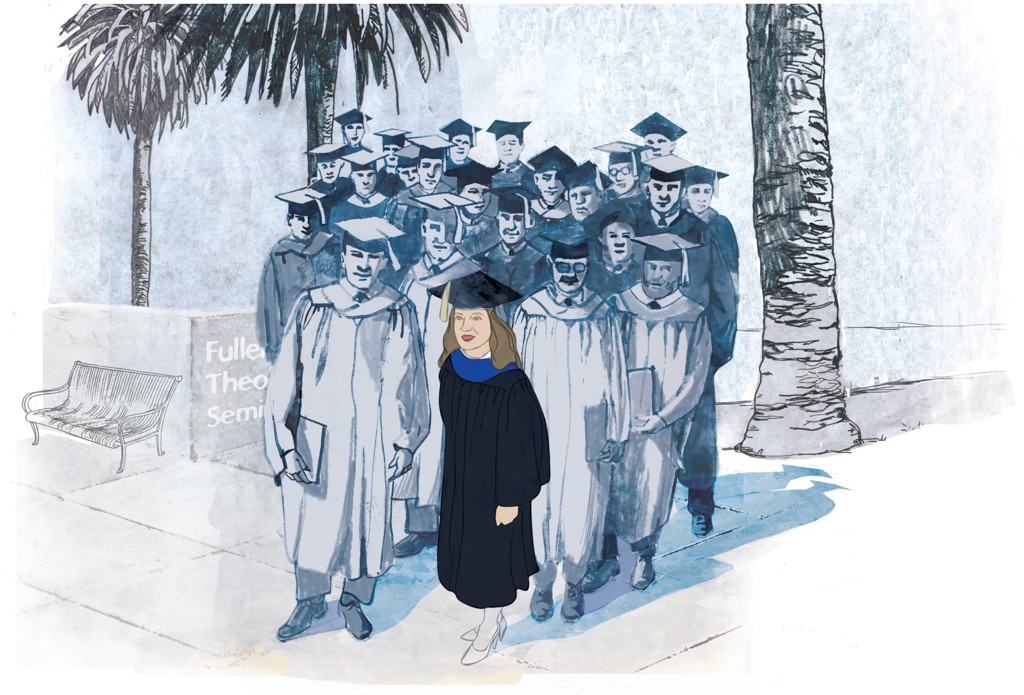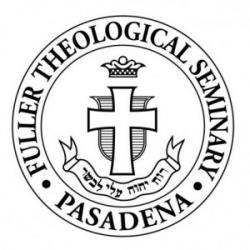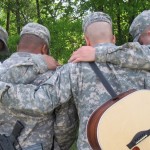One of Fuller’s defining characteristics is its commitment to women in ministry. What are the contours of that commitment?
MMT: The words that come immediately to mind are partnership, mutuality, interdependence, and the like. Fuller’s statement of purpose describes the seminary as “dedicated to the equipping of men and women for the manifold ministries of Christ and his church.” We construe “ministries” to encompass all that our three schools—Theology, Psychology, and Intercultural Studies—equip our students to do: teach, pastor, counsel, write, lead worship, engage in artistic endeavors, and many other vocations, too. We believe that the ministries of Christ happen inside and outside the walls of the church—in banks and schools and theaters and hospitals as well as in congregations. And we believe that men and women are equally called to and gifted for all these ministries: gender is no barrier when the Lord calls and equips someone for service, whatever it might be.
We also believe that “men and women” are called to minister and serve together; that men and women together constitute the body of Christ and are called to serve as its leaders and servants. In other words, we want to emphasize the mutuality that men and women share in carrying out the “manifold ministries of Christ and his church.” We don’t want to replace men with women. We don’t think male and female should be done away with, or that men and women are simply interchangeable in God’s creation. So we believe, for example, that marriage is between a man and a woman.
We acknowledge and celebrate the differences that may arise from our varied experiences in the world as men and women, believing that our mutual service enriches the body of Christ. Perhaps our commitment to mutuality can be summarized in the words of Paul: “in the Lord woman is not independent of man, nor man of woman” (1 Cor 11:11). If others emphasize hierarchy and distinctions in gender roles, we emphasize the ways in which men and women are “joint heirs” of the grace and the call of God.
JBG: I think of Fuller not only as the world’s preeminent evangelical seminary, but as a seminary that insists that the evangel, the gospel, embraces women and men as full partners in the good news of Jesus Christ and as equal recipients of God’s grace for salvation, ministry, and mission.
This means for us that the gospel is realized among God’s people such that we might take for granted that (of course!) both women and men have received gifts and graces for all sorts of ministries, for all kinds of ministry positions, for the full range of ministry roles in the church and world.
Together, women and men reflect God’s image. Together, women and men are clothed in Christ at baptism. And God gives both women and men as prophets and evangelists and teachers and pastors to equip God’s people for ministry.
Teaching at Fuller Seminary means that I needn’t regard these as contested claims, but can simply affirm them as central to the good news of Jesus Christ.
Women pastors, preachers, trustees, faculty, and students share stories from their long road to equality. Listen to Marianne Meye Thompson and others in their own words at our inaugural Story Table.
How did you get to the place in your own personal journey where you found yourself supporting or in agreement with this position?
JBG: I remember well the turning point. In the summer between my first and second years of seminary, I was a coleader of a summer youth camp. The other coleader was, like me, a male. The main speaker was a male. The worship leader was a male. And, without anyone saying that this is the way things must be, before the worship gathering on the first evening of the weeklong camp, several males retreated into a side room to pray for the (male-led) service and to lay hands on the (male) speaker. On the second morning, during a meeting of the camp staff, my wife of four months raised her hand and began voicing questions about why women were left to do the babysitting while men were off praying and leading. Happily for me, I wasn’t in charge of that meeting. The other coleader was the object of my wife’s concerns and he was able to lead the staff in a discussion of how responsibilities might be better divided.
Why didn’t it occur to me to raise those questions? I was raised in a traditional, Bible-believing church, one in which women, strong women, were involved in leadership, teaching, and so on. When I was in junior high and high school, the charismatic movement swept through our community. As a result, when it came to who did what, I suppose most of us were more interested in who had the gifts and call of God than in who was male or female. This changed when I was in college, though, as many of us were influenced by strong teaching affirming hierarchy and subordination (children subordinated to the mother, the mother subordinated to the father, and all subordinated to the pastor). Even if I didn’t explicitly teach and preach that message, looking back, it seems to have provided us with a kind of template for how things ought to work. After all, it was biblical, right?
In fact, when my wife raised those questions at that camp staff meeting, my first response was to think, “But that’s what the Bible teaches!” Then, like a ton of bricks, the question hit me: “Is that what the Bible teaches? Or is that what I’ve been told the Bible teaches?”
This was the beginning of a process of exploration that led to what would become my firm commitment to interdependence and mutuality. Over time, I underwent a kind of conversion—from the assumption that an all-male leadership team at a youth camp simply represented the way things should be to an assumption that no station, no role, no ministry was off-limits for women whom God had called and gifted.
MMT: If Joel remembers his “turning point” well, I’m not sure I remember any turning point at all. In the church in which I was raised through my college years, men and women worked side by side in most of the tasks of the church: teaching Sunday school, serving on boards, singing in the choir, leading in prayer, serving communion. The missionary whom our small church supported was a woman who served in India; the Sunday school teacher who taught me the fundamental narrative of Scripture was a woman. In fact, it was in this woman’s class that I answered the question “What do you want to be when you grow up?” with the reply, “A lady theologian.” No one ever told me I couldn’t or shouldn’t do that.
In other words, the life of the church was carried on by the shared service of men and women together. No one ever articulated the reasons for this mutuality and partnership, so far as I remember: it just happened, and I’m sure it must have shaped me both in what I value in the life of a congregation and in what I think that mutuality should look like in the church.
There were professors during my student years at Fuller who, in their articulation of support for women in ministry, further helped me to get my bearings. Among the many I could cite, I think of David Hubbard, Dan Fuller, and Paul Jewett. I remember reading both Man as Male and Female and The Ordination of Women by Dr. Jewett, listening to Dan Fuller interpret 1 Corinthians 11 and the case for women in ministry, and hearing President Hubbard articulate Fuller’s commitment to the partnership of men and women in the gospel. These teachers, and many others, helped put the scriptural and theological foundations under the practices and beliefs I inherited in the congregation of my childhood.
“People tend to think of me as a passionate preacher because I draw out the emotion in the text and in the characters that I highlight. Women see things in the text that men may miss. If only men can speak, there is an aspect that won’t be addressed. . . . As a woman, I can speak to something in men that a man can’t speak to, and as a woman I can speak to something in women that another man can’t speak to. The opposite is true as well: men can speak into women, men can speak into men—but together we can speak into each other most fully. Men and women together are able to reach the totality of the human experience.”
 We’ve Come a Long Way and Still Longer to Go, So Help Us, God!
We’ve Come a Long Way and Still Longer to Go, So Help Us, God!
“Although the path is uphill and ‘checkered,’ the number and visibility of Latinas serving as pastors and in key leadership roles seems to be moving slowly but steadily forward.”
Read more from Zaida Maldonado Pérez, professor of church history and theology at Asbury Theological Seminary.
Which passages in Scripture are fundamental as support for Fuller’s (and your) position?
JBG: Two or three come to mind. The first is the creation account in Genesis 1. When God creates humanity, he creates them male and female, and it’s precisely as male and female that they’re created in God’s image. From the outset, from the very beginning, as Scripture begins to lay out the nature of humanity, we have this clear affirmation of partnership, of full equality between male and female. I think there’s an important sense in which that’s picked up again in Acts 2, when, in his Pentecost address, Peter draws on the language of Joel 2:28–32. Here we find Peter speaking of the coming of the Spirit on all people, with the result that “your sons and daughters will prophesy.” “And they will prophesy,” Peter says. The same theme is in Galatians 3:28, where the divisions that separate people in the real world, slave or free, Jew or Greek, male or female—are simply flattened or leveled in Christ, as a consequence of God’s new creation. It’s not hard to imagine that, here, we find ourselves back at the beginning, considering God’s purpose in creating male and female, together, in God’s image.
MMT: I agree with Joel on the significance of the account in Genesis for thinking about gender relations and the roles of women in leadership among the people of God. I sometimes use the image of “trajectories” that run through Scripture on various matters, such as clean and unclean food or keeping Sabbath; we are guided by these trajectories to think with Scripture. I find a trajectory that begins in Genesis, with the creation of humankind in the image of God: “male and female, he created them” (Gen 1:27). That verse is of course cited by Jesus when he explains the significance of marriage (Matt 19:4) as the union (“one flesh”) of male and female. As Joel hints, the account of creation of humankind as “male and female” is also alluded to by Paul when he celebrates the reality that in Christ there “is no longer Jew or Greek, there is no longer slave or free, there is no longer male and female; for all of you are one in Christ Jesus” (Gal 3:28). Even as Christ’s life, death, and resurrection breaks down enmity between those of various ethnicities and different status, so it (re)unites men and women together. In Christ, God’s purposes for humankind as male and female are brought to their fruition.
That’s the great arc or trajectory that runs from Genesis to Jesus to Galatians—an arc that bends toward mutuality and unity. That is what I think needs to be modeled in the “manifold ministries of Christ and his church.” If in Christ, the church is the “new humanity” (Eph 2:15), it needs to model and embody the reconciliation and peace that Christ brings about. One of the ways in which we show this is in the mutuality of service shared by men and women.
We see this in the New Testament narratives, when Priscilla and Aquila instruct Apollos in the ways of the Lord (Acts 18:26); Paul later sends greetings to “Priscilla and Aquila, my coworkers in the ministry of Christ Jesus” (Rom 16:3). Paul doesn’t seem to distinguish between what Priscilla and her husband, Aquila, did or were allowed to do. Paul also commends many women for their work (see Rom 16:1, 6–7, 15). So far as we can tell, he simply regards them as his partners in the “manifold ministries of Christ and his church” with no distinction between men and women at that point.
How do you understand passages in the New Testament or elsewhere in the Scriptures that appear to bar women from teaching or positions of leadership within the church?
MMT: We recognize that not everyone sees things the way that we have just set them forth, not everyone reads the arc or grand story of Scripture to begin with this creation of men and women for each other and then ground this mutual service of men and women together in the reconciling work of Christ. For some interpreters, there are texts that point in other directions. For example, in his letter to Timothy, Paul writes that women are not to “teach or to have authority over a man.” At least that’s what a number of translations say. Here’s another version: “I don’t allow a wife to teach or to control her husband” (CEB). That’s a legitimate translation too. But what is curious is that this passage in 1 Timothy seems to push in a different direction than many of Paul’s other statements, as well as against the grain of some other New Testament texts. What do we do with that? My view—given the trajectory of Scripture from and toward mutuality and partnership—is that in Paul’s other letters he seems to regard women as full partners in the work of the gospel, and that other books of the New Testament show women prophesying and witnessing and instructing. Then, this passage in 1 Timothy must present an exception to normal practice. Is Paul’s concern raised by those who deny the goodness of marriage (1 Tim 4:3)? Is he worried about some women who “have already gone astray” (1 Tim 4:15)? I think we must fit Paul’s instruction here into the larger trajectory that runs from Genesis to Jesus to Galatians and beyond. That overarching trajectory shows us how to think about this one particular passage and marks it out as addressing a specific problem or issue.
JBG: We take seriously Scripture’s authority, so the easiest option for dealing with those passages isn’t available to us! That is, we can’t just ignore them, or write them out of our Bibles. Nor, to my way of thinking, can we claim, say, that if 1 Timothy isn’t written by Paul we don’t need to take it seriously. Apart from the fact that we can make a good case that Paul did write 1 Timothy, irrespective of its author 1 Timothy is included among the New Testament Scriptures.
To embrace Scripture’s authority sometimes means struggling with it. It is precisely because we affirm Scripture’s authority that we must struggle with it, rather than ignore or dismiss texts that trouble us. What might this struggle look like? We might take notice of those texts that promote the status of women in positions of leadership in families, tribal groups, and churches. We might account for the historical contexts within which these documents were written. We might listen to how the global church and the church across time has heard and reflected on these texts. And we might work to understand individual texts within the whole of Scripture’s testimony.
What we cannot do, it seems to me, is isolate one text as though it speaks authoritatively by itself. To take the same passage that Marianne pointed to, I find myself puzzled by some views of 1 Timothy 2:11–12: “Let a woman learn in silence with full submission. I permit no woman to teach or to have authority over a man; she is to keep silent” (NRSV). Some appeal to this text as though it definitively resolves our questions. I wonder: Why do we imagine that we can draw on this text to silence women, without at the same time insist on raising holy hands or legislating against braided hair (1 Tim 2:8–15)? Why do we take these two verses in such a straightforward manner but not divide widows into the older-than-60-years group and a younger-than-60-years group (1 Tim 5) before we sort out how best to care for them? How can we focus on these two verses without taking seriously the agenda of the entire letter, so clearly articulated in 1 Timothy 1, and without struggling with how these verses might fit within the overall context and aim of the letter? And why would I take 1 Timothy 2:11–12 as my starting point, rather than those plentiful texts that refer to women as prophets, evangelists, apostles, benefactors, and so on?
 Women’s Leadership in the African American Church
Women’s Leadership in the African American Church
“In African American churches, women’s leadership includes all areas of responsibility—from the more traditional roles as leaders of women in missionary societies and women’s groups, to congregational leaders in areas such as Christian education and pastoral ministry. My reflection on women’s leadership in African American churches will include a brief overview of women’s leadership, potential impediments to women’s leadership, approaches to addressing these obstacles, some of the contributions of African American women, and signs of hope and encouragement.”—Alexis Abernethy
What role does Fuller play in helping this dialogue continue in a civil manner?
JBG: I recognize that the evangelical world is not of one mind on this issue. I am hopeful that we can reason together with our evangelical friends who are not as convinced as we are regarding the status and role of women among God’s people. Civil conversation with those with whom we disagree—whether in our classrooms or in other media—will require us to put forward our best understanding of the Scriptures and our best reading of the church’s tradition, while doing so with humility and conviction.
At the same time, I have to admit that my first concern isn’t dialogue. I want for women to find at Fuller Seminary a place where their gifts and graces can be discerned and explored and affirmed, where hard questions can be asked and thoughtful answers provided. First and foremost, I want women to find at Fuller a community, including a community of faculty, committed to the formation and empowerment of women and men for the manifold ministries of Christ and his church, in the church, in the marketplace, and in the world.
MMT: At Fuller, whether in the classroom or for churches, we try to model and encourage what we’ve been talking about: a gracious mutuality between men and women that respects the authority of Scripture and seeks to strengthen the body of Christ in every way. We recognize that not all our Christian brothers and sisters agree with the way that we read Scripture at this point. In fact, many of both our male and female students come from and will return to arenas of service in which the commitments we have are not shared. But that’s true for other commitments we have too! So, I think we try to find ways to help our students to speak with the “convicted civility” about which our former president, Richard Mouw, often spoke so fervently. We have convictions; some are not shared by all the church, some are not shared at all by our culture. To live “against the grain” in either case isn’t easy: it requires conviction, courage, civility, humility, and hope. I hope that what we model and teach can help to foster that way of living in the body of Christ and in the world.












